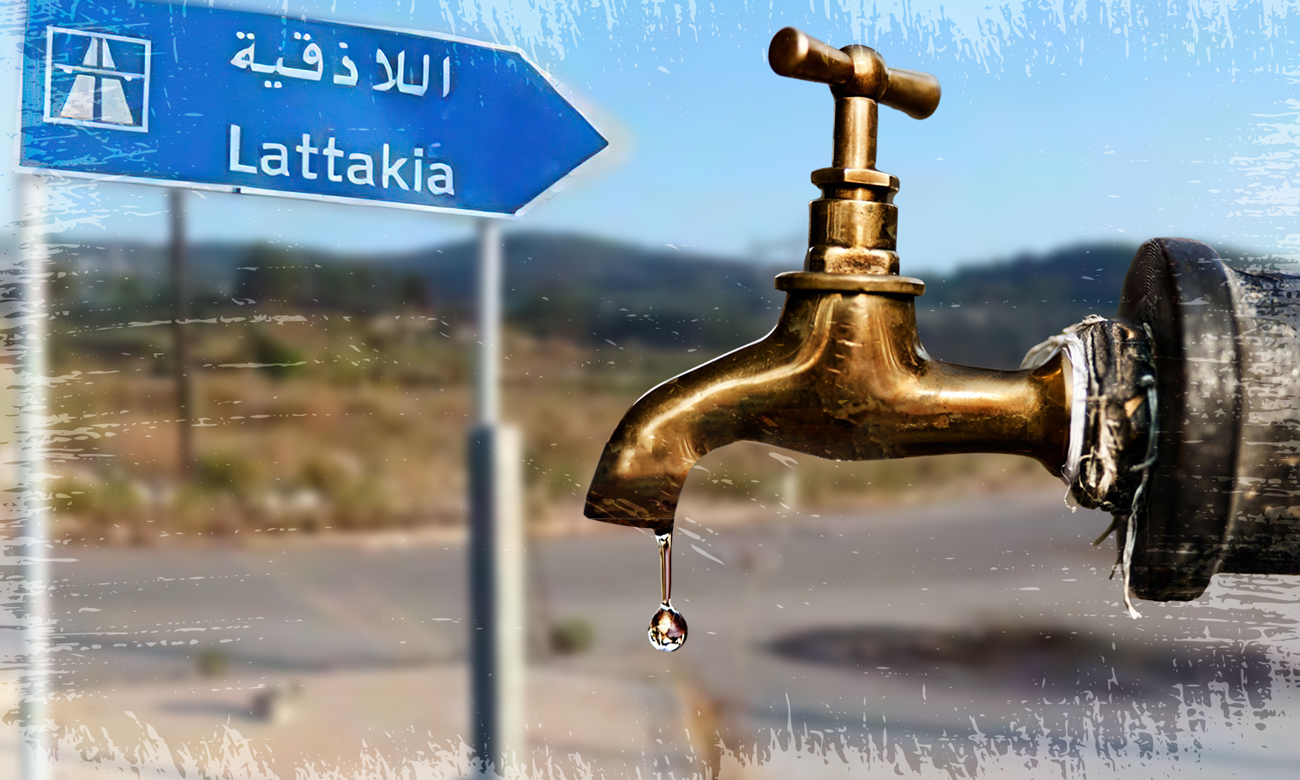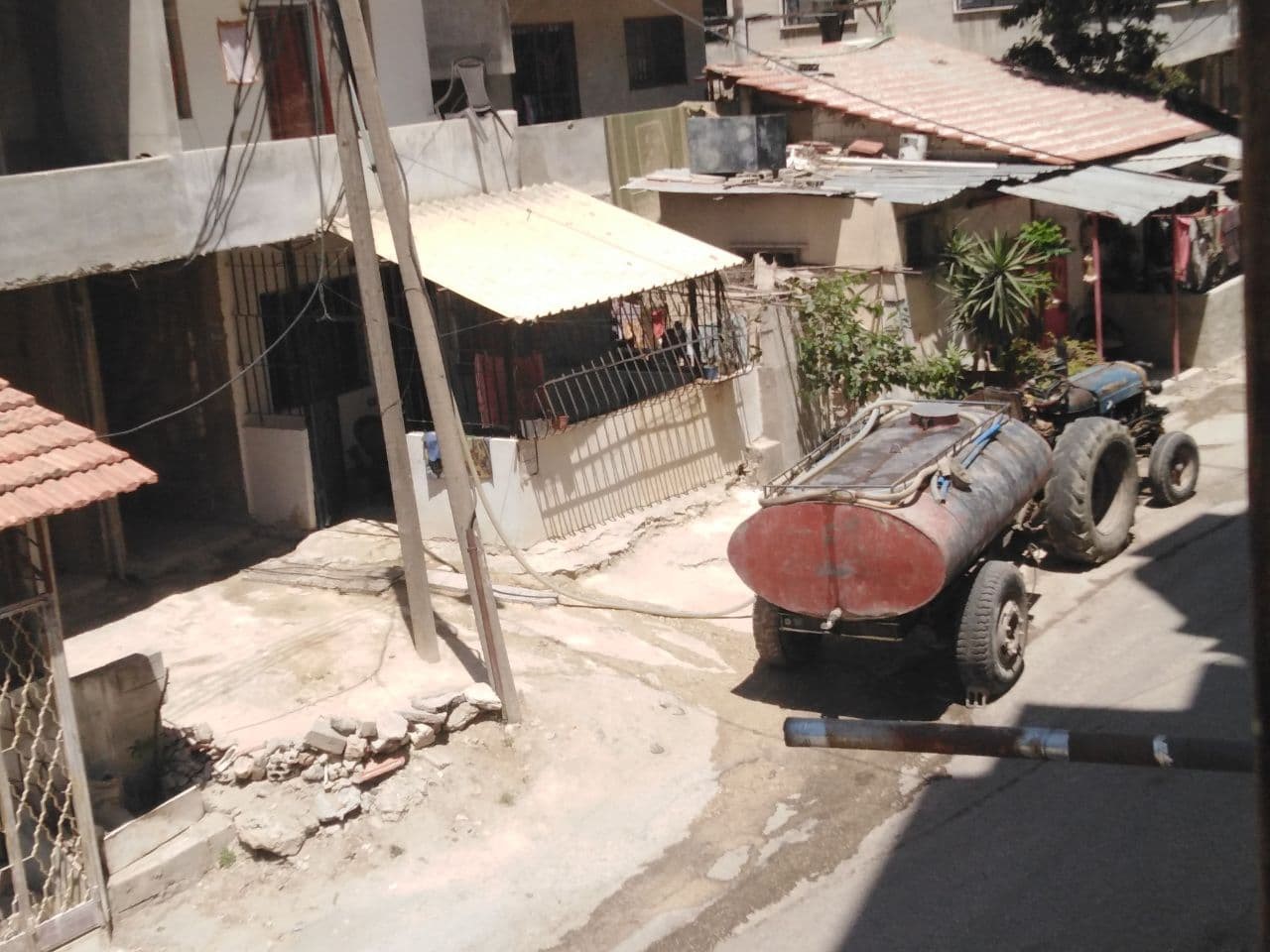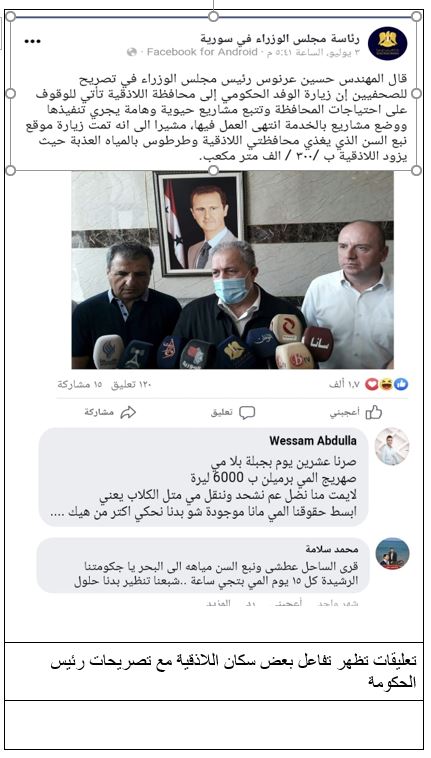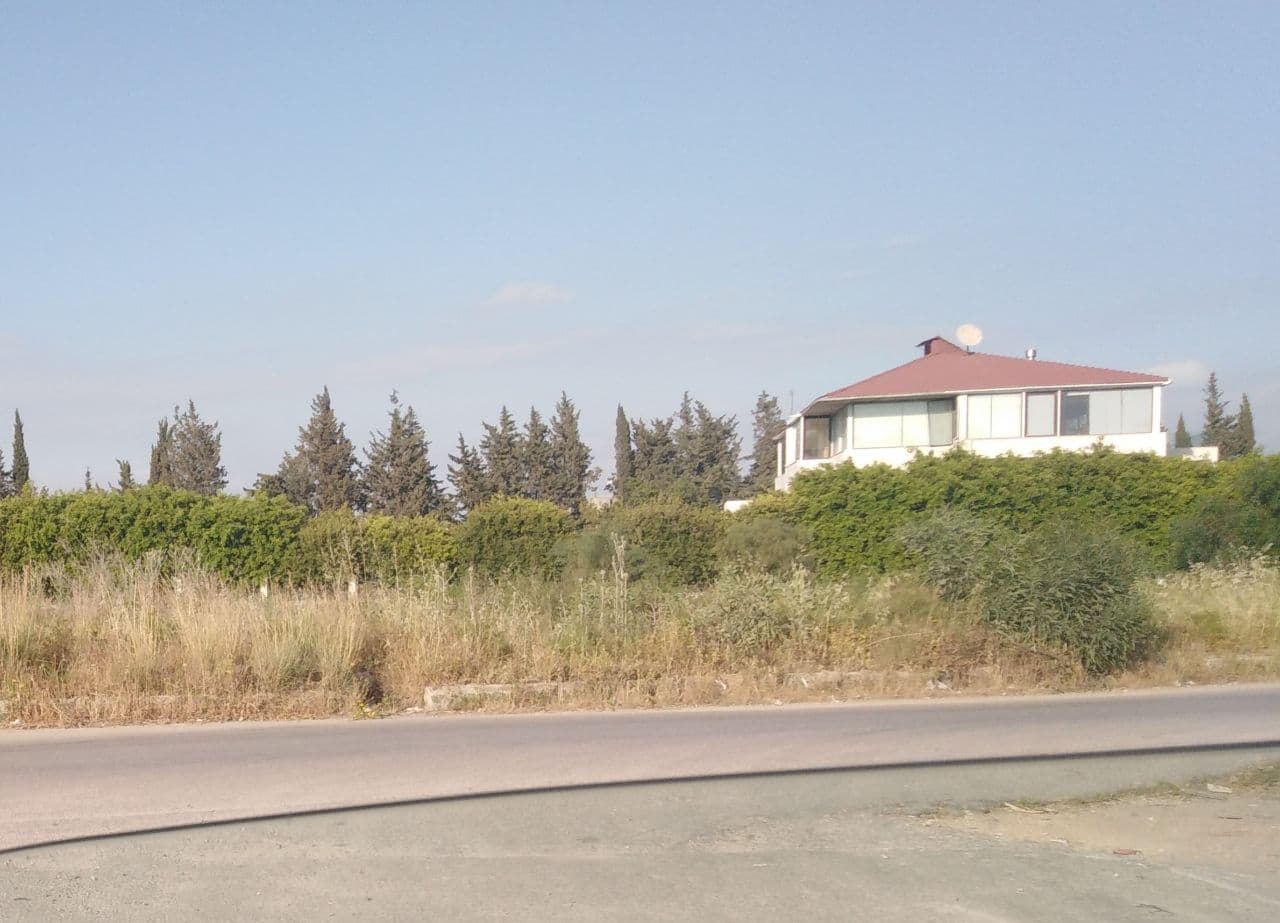Investigation: Al-Hussein Masoud (pseudonym)
Editing and supervision: Ali Eid
An investigation carried out by the independent Syria Indicator project for investigative journalism, which reveals the role of infringements on water lines (theft) in the thirst in the Syrian city of Latakia. It also reveals the involvement of influential army figures and intelligence officers in water theft to irrigate their farms and fill the swimming pools of their villas.
On the Syrian coast of the abundantly rainy city of Latakia, which is blessed with springs, short rivers, and dams, family breadwinners currently spend their entire salary to purchase water, with the price of the tank (about 1,000 liters) ranging from 8000 to 10,000 Syrian pounds. According to Dalal (a pseudonym for security reasons), who lives in a village bordering Latakia, a family needs to buy this quantity four to five times a month.
Another witness, who preferred to refer to his name by initials (B.A) for security reasons, points out that the purchase of water from vendors (owners of tanker trucks) is caused by the long and frequent water outages, which sometimes last up to 20 days.
In early July, social media users on Facebook interacted with the statement the Prime Minister of the Syrian regime government, Hussein Arnous, had given to reporters during his visit to Latakia; he said that the al-Sin water spring provides the governorate with about 300,000 cubic meters per day, which covers 80 to 85 percent of the governorate’s water needs according to government and specialist estimates.
One of the respondents said that the city of Jableh has been without water for 20 days, while another said that water only arrives every 15 days.
According to one of the city’s residents, thirst has come to resemble the poet’s saying, “camels traveling the wilderness are dying of thirst while carrying water on their backs.”
From where does Latakia get its water?
According to figures obtained from a source working in the spring’s administration, Latakia obtains 85 percent of its drinking water needs through traction lines coming from the al-Sin spring (40 kilometers south of Latakia), one of Syria’s most abundant, fresh, and purest springs located below Mount Qurfis on the Syrian coast. Water is pumped from the spring through three lines to collector tanks at the top of Mount Qurfis (2500 meters east of the al-Sin spring), where water flows from there through three pipelines northward to Jableh, the city of Latakia, al-Haffah, and Qardaha. A fourth traction line has not yet been connected to the spring. All year long, pumping at full capacity does not stop.
Auxiliary sources (springs and wells) provide the remaining 15 percent of water needs, the most important of which are the al-Safsaf, al-Bahlouliya, and al-Jandiriya wells and the Jorin spring. In addition, local drinking water springs available in each region are utilized.
The paradox with the governorate of Latakia is that it contains the best water resources in Syria, where studies and figures, including those confirmed by the Fanack.com website specializing in water resources, indicate that the coastal basin falls within the first rainy region. The average annual precipitation is between 400 and 650 millimeters, and the volume of available conventional water is 4,160 million cubic meters, equivalent to 23 percent of Syria’s resources.
According to a 2012 study published by the Syrian Tishreen University, the annual per capita share is 107.08 cubic meters in the center of Latakia, about 88 cubic meters in the city of Jableh, and more than 94 cubic meters in Qardaha. This share decreases in rural areas with a minimum of 32 cubic meters per person per year. However, these ratios do not correspond to what has happened in recent years, with the lack of government transparency in this matter and the lack of official data on per capita share for at least the last five years (we tried to research private and open sources and we found nothing).
According to a statement by the Water Director in the governorate, Eng. Mudar Mansoura, in mid-2020, thirst in Latakia and its countryside indicates a breakdown in the drinking water service system rather than in natural water sources; he noted that “the stock is good” and that it covers “essential needs.”
Where does the water go?
According to a source in the Public Establishment for Drinking Water in Latakia who preferred not to be named, the spring pumps about 310,000 cubic meters daily (at a rate of four meters per second), of which Latakia’s share is 232,500 cubic meters (three cubic meters per second), presumably covering 85 percent of the population’s needs. However, only 205,400 cubic meters reach collector tanks in the governorate (at a rate of 2.65 cubic meters per second), with losses amounting to about 27,000 cubic meters per day, equivalent to 11.6 percent of the water pumped to collector tanks via main lines.
While those involved hold power outages responsible for the lack of water in their statements, one of the engineers of the Latakia Water Unit (who recently left service) says that “outages take place in summer and winter. The pretext that we tell people is that power outages cut off electricity supply to the city and the water pumping stations in the countryside, in addition to the reduction in fuel allocations to the stations that have fallen below half”.
He continues that “the electricity pretext is no longer a good reason after coordination took place between the Directorates of Electricity and Drinking Water, which reduced the possibility of power outages being the reason for the water crisis.” So, what is the reason?
The same source indicates that estimates of phase one water loss due to infiltration, leakage, and high-temperature range between 2 and 3 percent of the total amount lost, meaning that a confirmed proportion of water lost ranges from 8 to 9 percent at an average rate of 20,500 cubic meters per day, a confirmed quantity that goes by an unknown route that is not associated with infiltration and leakage. Another phase two loss is not known in quantity but is no less than that of phase one, which is the phase of pumping water from tanks to neighborhoods and villages because most infringements happen to sub-lines in villages far from being monitored.
This means that we are facing a loss of more than 23 percent of the water pumped. The proportion of stolen water ranges from 16 to 18 percent of that loss at an average rate of 41,000 cubic meters per day, an unconfirmed amount by the concerned authorities. According to the investigation witnesses, this explains the large number of illegal violations and theft of water.
Infringements are the reason
In order to ascertain the allegation of a number of witnesses about the infringements and theft of water from traction lines coming from the al-Sin spring, which are the most important causes of water outages and shortages, we asked the former water unit engineer, who nodded in confirmation, saying that, in many cases, no one dares to even say a word about it. He added, “They are the whales,” suggesting that there are thousands of cases of illegal watering of crops and greenhouses.
While Latakia’s concerned authorities repeatedly claim to control encroachments, our previous witness asserts that the removal of encroachments only affects certain people and not those with security or military influence or influence obtained from an official position; these people draw drinking water to their farms to fill swimming pools and water their farms and private orchards.
According to the data of the Latakia Establishment for Drinking Water, 737 violation control reports were made during the first half of 2020, while 1,213 pumps and 7,782 violating pipe connections (infringements) were removed.
According to the Director-General of the Establishment in an official statement to the Syrian Arab News Agency (SANA), 237 violation reports of varied misconducts were carried out in all regions, and 1,257 violating pipe connections were seized in June of 2020 alone. These reports cover infringements on the three traction lines, at an approximate rate of 212 infringements on each line. However, infringements increase on unchecked traction lines in distant areas.
Puncturing lines
Traction lines are lines made of cast iron or stainless metals with a diameter of at least one meter. These lines transport water from the al-Sin spring to Latakia, all located below the ground at a depth of between three and five meters. The lines’ trajectories can be detected because of the existence of points known as pneumatic vents, which are devices for leaking air pressure from pipes. An engineer from the station’s pumping directorate (whose name shall not be disclosed for security reasons) says that the majority of “underground passage routes are known to the inhabitants of the area.”
According to Hussein (a pseudonym for security reasons), a worker at the Establishment for Drinking Water in Latakia, the infringements on these lines mean puncturing them using electrical or manual drilling tools and creating circular holes of different diameters in the body of the pipe, then installing valves on them, followed by lines to transport water from them to other places. The high pumping pressure from the al-Sin station makes it easy for water to flow to collector tanks, eliminating all need for electric power pumps.
The majority of farmer-perpetrated encroachments are small in size, with diameters of 0.5-0.75 inches (water flow measurement unit), and are carried out on branches emerging from the main traction lines, which are exposed lines. But invisible encroachments are the most important and have the biggest impact and are located on the main traction lines hidden underground. Such encroachments cannot be detected without specialized devices, and that is the reason why most of the locations of infringements are only recognized through people’s testimonies.
Hundreds of millions in losses
In order to estimate financial losses resulting from infringements and theft from traction lines, the price was calculated on the basis of stolen water uses, namely watering crops and filling swimming pools, which means that they fall within the commercial, industrial, and tourist utilization bracket. The price per cubic meter is 60 Syrian pounds, according to the website of the Latakia Public Establishment for Drinking Water.
When calculating numbers and prices, the value of stolen water is equal to the amount multiplied by its price, reaching approximately 449 million Syrian pounds per year, based on confirmed stolen loss. If we add the total stolen loss to the estimate, the economic value of the stolen water will amount to 897 million Syrian pounds, which could have been used in other things, such as digging new wells or repairing ones that are dilapidated. So, where does this quantity go?
A tour of revelations
In the investigation tour on the route of the second traction line that runs with the old Baniyas-Jableh road, a number of infringements were documented, and their coordinates were registered with the help of Google Earth. A number of farmers have confirmed the existence of permanent encroachments aimed at watering protected crops, most of which are greenhouses dedicated to growing vegetables, but discovering them is not easy, as the perpetrators are subject to legal accountability. Infringers do not state the direct cause of such encroachments in light of the presence of water channels designated for irrigation.
One farmer (who asked not to be named for security reasons) justified that by saying, “We are closer to al-Sin River than any other city or village, yet we often suffer from drinking water outages. Therefore, the solution was to obtain water from the traction sub-lines heading to other villages and to conceal these lines from water control”.
When detected by water control as a result of information obtained from neighbors or other entities, water control edits a transcript of the violation and removes and confiscates the pipes. But it may happen that pipes are dismantled without registering an offense, depending on the case. Ahmed (a pseudonym for security reasons), a worker at the Water Directorate, states that water control has detected numerous thefts in the past period in the Basateen al-Sawaj area (near the city of Jableh).
Thieves the size of whales
During months-long surveillance of traction lines tracks at a number of points, while indirectly listening to people’s conversations, residents of the area were found to be circulating the names of a number of officers, including those who are still on duty, and others that are retired, but had not lost their authority as proved by guards in military uniforms on the entrances to their villas. However, the difficulty of checking water theft points from within these officers’ villas, which are surrounded by fences and guards, has prevented the documentation of infringements.
As part of an ongoing search, we were able to pick up a clue that might confirm people’s talk; the owner of a shop on the Latakia-Tartus highway indicated that there was an infringement on the entrance to the city of Jableh. The investigation team ascertained that there was a pool inside the villa, which is surrounded by guards 24/7.
(Picture below: the villa in a close-up shot from the air via Google Earth)
With the assistance of an offense monitoring officer and a person who worked as a guard for the villa earlier (who cannot be named for security reasons), the pool belongs to Colonel Mohammad Alloush, an officer of the Presidential Palace.
The witnesses confirmed that the pool was filled by special pipes sourced from the first traction line, which were installed years ago by guards on the order of the officer owning the villa, in addition to watering at least three dunums of lemon trees and fruits.
We toured the villa’s perimeter by car (documented by video), where we encountered a security barrier meters away on the public street off the villa.
In another location near Latakia, the employee who specializes in monitoring violations helped us identify another infringement. It was found that the villa on the Jableh-Latakia road is supplied with drinking water through two sources; the first being less frequently used regular water lines, while the second is a line drawn in violation of the first underground traction line north of the villa, which is water intended for the swimming pool.
The specialist employee’s testimony matched testimonies of nearby witnesses and that of a guard, who, when asked by the investigation team, had replied that the trespassing line had existed for years.
By cross-examining testimonies, we learned that said villa belongs to Brigadier General Ibrahim Mohammad, an officer of the Republican Guard. Through the presence of guards in military uniforms, its owner is found to be a person with a prestigious position who continues to have a mighty presence and a remarkable power.
The guard said, “My boss (Officer Ibrahim Mohammad) only visits the villa during the summertime.”
In the Ras al-Ain area of Jableh, the investigation was able to detect another violation in a villa near the al-Marjan Bridge.
The employee who previously documented the violation, without the Establishment for Drinking Water being able to remedy it, said that “there is a four-inch (about ten centimeters) diameter pipe in a hidden place, reaching directly from the second traction line to the fenced villa.”
A lady in her sixties said everyone in the vicinity knew the villa owner was stealing drinking water, but nobody dared hold him accountable.
The investigation sought to identify the name of the villa’s owner, finding that said property belongs to retired Brigadier General Mohammad Sater, a former officer of the Presidential Palace who had worked for many years in Lebanon.
Penalties that encourage corruption
The investigation brought these infringements to the attention of a number of administrators at the Public Establishment for Drinking Water, but they declined to comment on the matter. However, an employee pointed out to us that the Establishment had tried several times to remove such encroachments but failed because of these persons’ security and military ties. However, this source could not determine the number of infringements and individuals stealing water.
With regard to the legal aspect of the infringement, lawyer Murhaf. M said that it constitutes “an explicit legal violation in its encroachment on public property and causing partial or total harm to others.” Water Investment Law No. 31 of 2005 states in Article 35 that “Anyone who intentionally destroys or vandalizes in whole or in part one of the main irrigation facilities, such as dams and pumping stations, or intentionally contaminates water sources shall be liable to a penalty of one to three years’ imprisonment and a fine up to 200,000 Syrian pounds (80 USD at the time of preparing the investigation). The penalty is reduced to six months to one year’s imprisonment and a fine of up to 100,000 Syrian pounds (40 USD) for anyone who intentionally destroys or vandalizes in whole or in part one of the water utilization facilities and its annexes, such as switchers, drinking and irrigation channels, and main drainage canals. In all cases, the perpetrator shall be obliged to pay for the damages resulting from the act”, provided that they do not violate harsher penalties stipulated in the Penal Code or any other law.
The lawyer points out that at the time of the law’s enactment, these amounts were equivalent to an average of about 500 USD and were high at the time of their promulgation, indicating the seriousness and resolve of the legislator to suppress such infringements. At the present time, however, it is not of much value, which encourages the continuation of these encroachments on the one hand while at the same time allowing water control to overlook them in view of the widespread corruption and the absence of legal and executive mechanisms that are not individual-related.
if you think the article contain wrong information or you have additional details Send Correction
النسخة العربية من المقال
-
Follow us :
Most viewed
- After Turkey and the opposition, SDF shows willingness to dialogue with Syrian regime
- Syrians pack their bags in Turkey
- Potential Erdoğan-Assad meeting in Moscow: Talks of excluding Iran
- European countries call for re-evaluation of policy towards Syria
- Al-Assad reproduces Constitutional Committee through People's Assembly



















 A
A
A
A
A
A











 More In-Depth
More In-Depth